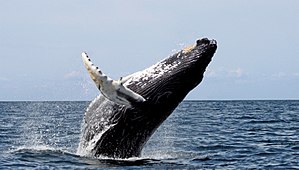Pacific Islands Cetaceans Memorandum of Understanding
 |
|
| Context | nature conservation |
|---|---|
| Effective | 15 September 2006 |
| Signatories | |
| Languages | English and French |
The Memorandum of Understanding (MoU) for the Conservation of Cetaceans and their Habitats in the Pacific Island Region is a Multilateral Environmental Memorandum of Understanding concluded under the auspices of the Convention on Migratory Species of Wild Animals (CMS), also known as the Bonn Convention, and in collaboration with the Pacific Regional Environment Programme (SPREP). The MoU provides an international framework for coordinated conservation efforts to improve the conservation status of the Pacific Islands Cetaceans and came into effect on 15 September 2006.
The MoU covers 22 range States (Australia, Cook Islands, Federated States of Micronesia, Fiji, French Polynesia, Kiribati, Marshall Islands, Nauru, New Caledonia (to France), New Zealand, Niue, Palau, Papua New Guinea, Samoa, Solomon Islands, Tokelau, Tonga, Tuvalu, United Kingdom (Pitcairn Island), United States (including American Samoa, Guam and the Northern Mariana Islands), Vanuatu and Wallis and Futuna (to France)). As of September 2012, 15 States have signed the MoU as well as a number of co-operating organisations.
Whales and dolphins (cetaceans) migrate over large distances, connecting ocean ecosystems and cultures throughout the Pacific Islands Region. Despite restrictions on commercial hunting imposed by the International Whaling Commission, such as the international moratorium on whaling, populations have not recovered to pre-whaling levels and many species are listed in the highest risk categories of the IUCN Red List. To provide a framework for governments, scientists and other to monitor and co-ordinate conservation efforts, a MoU was launched on 15 September 2006.
Signatories to the Pacific Islands Cetaceans MoU:
In addition, the following organisations have signed the MoU:
Although most of the Signatories have only small land areas, they are of the highest importance since they are surrounded by huge Exclusive Economic Zones, covering millions of square kilometres of sea, which the cetaceans use as migration routes.
...
Wikipedia
